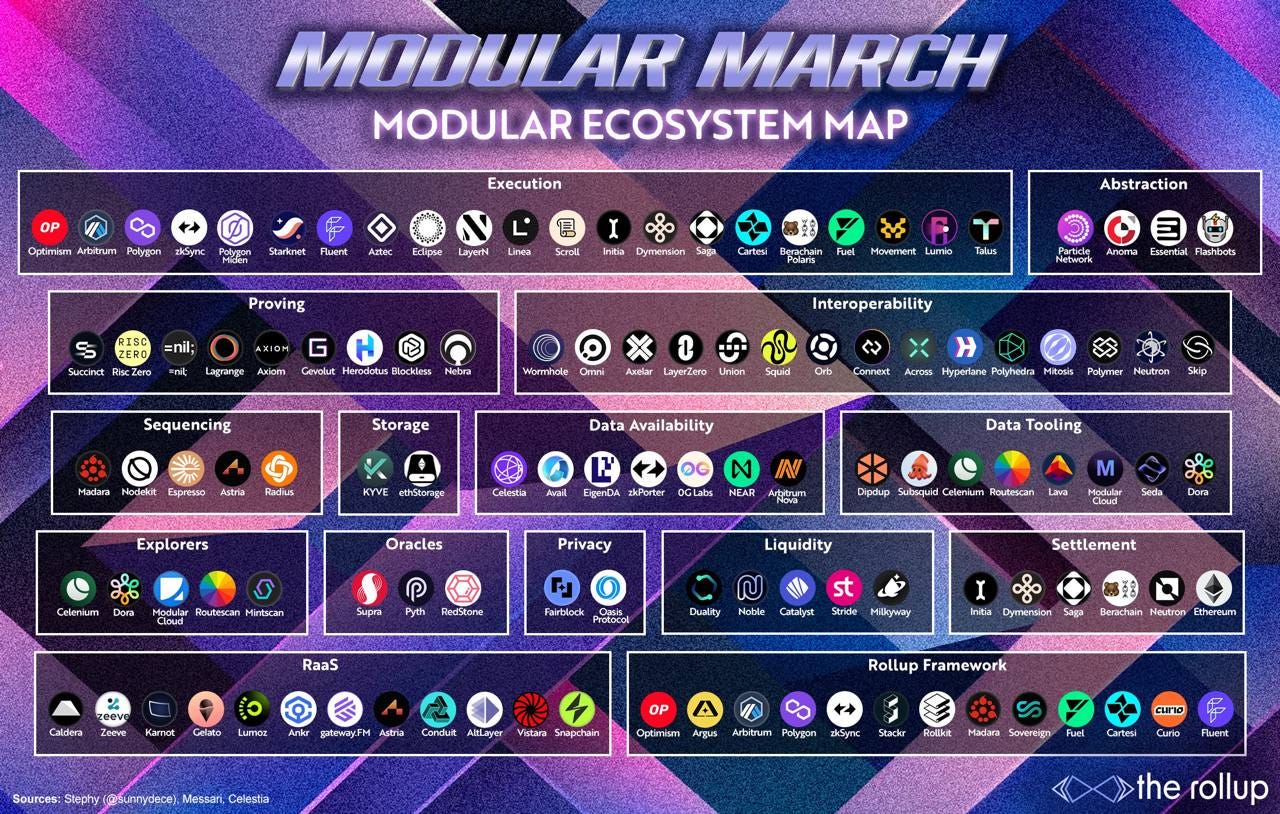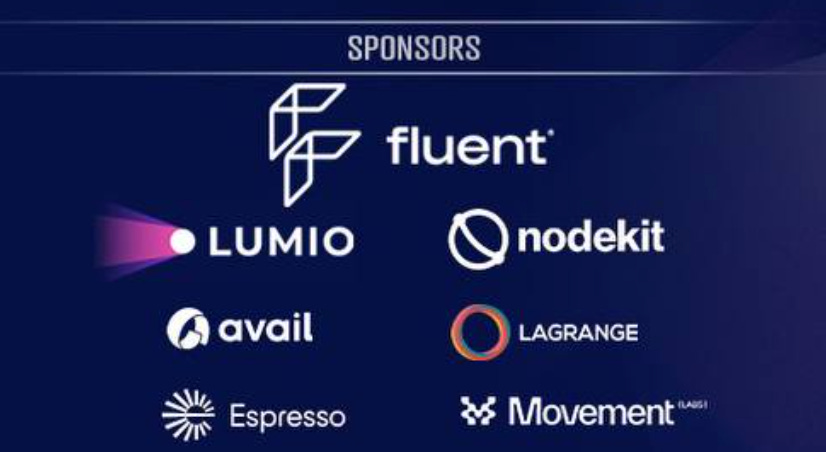An Introduction to Modular Blockchains
Over the past couple of years, we’ve seen a significant shift from the once traditional monolithic approach to the new, modular blockchain paradigm. I mean, it seems like every week now we’re seeing a new team pivot to a modular L2, whether Aevo, Mode, Cronos, etc. & sure, some teams may be making the switch to capture all the user’s hunting the next potential airdrop, but most are doing so because of the transformative approach it offers in designing networks that are not only scalable and secure, but also adaptable to the evolving needs of the industry.
But how did we get here? That’s what we aim to answer here - we’ll walk you through an introduction to modular design, tracing its origins, the benefits it provides, and how its grown & evolved.
Before we begin however, we want to thank Fluent for being the title sponsor for Modular March! Fluent is a zkWasm-based Ethereum that is aiming to onboard the 20M developers across the world into web3. They’re live on private testnet today.
What is modularity?
The concept of modular design in systems was prevalent well before blockchains even existed. However, at its core, the principle remains the same: dividing a system into separate components, each tasked with specific features or functions.
Origins of Modular Design in Computer Systems
In the early days of computer programming, developers had to write programs that did everything the computer needed to do all in one piece of code. So it was like a big sequence of instructions that performed all the various, necessary tasks.
Then, developers started breaking these programs into smaller pieces, or modules, each of which being responsible for their own respective tasks, whether a module for adding numbers, or for sorting data. This idea of breaking down programs into smaller modules laid the foundation for what we now call modular design. This design principle enabled developers to focus on specific pieces individually, making it easier to test and modify, thereby increasing overall productivity.
This even extended to the computer hardware - you have memory chips, processors, keyboards, monitors, printers, etc. All of these are individual components that could be replaced or upgraded without affecting the entire system. You want a new mouse? Just swap out your old one for a new one. No need to buy an entirely new computer.
But even aside from just computer systems, the modular paradigm can be seen across a variety of different industries:
Modular Homes
& if you notice, one of the key benefits of modular design in these homes & sofas examples is customization. This is something that extends to blockchains as well, and in fact, aligns with one of the core ethos of modular blockchains - build whatever.
Legos
I think Lego’s showcase the concept of modularity best - there's a reason we tend to call our community “bricks” sometimes (lol):
Components: legos come in all shapes and sizes, however, they can all connect with each other thanks to the standardized connectors on the top and bottom of the lego (they can snap together to connect) - these bricks serve as the building block for creating larger structures
Flexibility and creativity: the bricks can be assembled any way you want, from a house to a car. This ultimately allows builders to experiment with different arrangements and combos to achieve their desired design
Ease of assembly and disassembly: can modify and rebuild creations because of how easy it is to add or remove blocks
reusability: can be reused to build new things
Interchangeability: legos from different sets are often compatible with each other, allowing users to combine legos from different sets
Modularity in Blockchain Systems
Blockchains have followed a similar path, embracing a modular approach that has spurred the rise of a flourishing ecosystem. Similar to traditional computer systems, modularity in blockchains involves breaking down these complex systems into smaller, more manageable components that perform their own unique roles.
Initially, there were four main components:
Execution
Settlement
Data publication
Consensus
& up until a couple of years ago, all blockchains followed the monolithic approach, whereby all four of these components lived within a single layer.
However, a pivotal moment arrived in 2019 with Celestia’s publication of the “Lazy Ledger” whitepaper, which proposed the idea of separating execution from data publication & consensus, thus pioneering the concept of modular blockchain design.
Soon after, Ethereum also followed suit by embracing a rollup-centric future, further advancing the modular blockchain paradigm. For Ethereum, this modular approach was a strategic response to scalability issues posed by the blockchain trilemma, resulting in slow transaction speeds & high costs.
The blockchain trilemma said that a blockchain could only excel in two out of the three points: decentralization, security, and scalability. Ethereum originally prioritized decentralization and security, while alternative Layer 1 solutions competed by emphasizing scalability over one of the other two factors.
However, through a modular approach, blockchains can begin to untangle this trilemma by employing separation of concerns. With Ethereum, rollups will handle scaling, while Ethereum base chain (the Beacon chain) handles security and decentralization.
Fast forward to today, and nearly every new blockchain project is embracing this modular vision with enthusiasm.
Just take a look at the difference in projects from Modular Summit 2022 vs 2023.
vs. now, March 2024:
Another noticeable shift has been in the increasing sophistication of modular components. As previously mentioned, there were originally only four main components: execution, settlement, data publication, and consensus. However, the ecosystem has since witnessed the rise of additional layers such as:
sequencing layers
proving layers
rollup frameworks
RaaS
bridges (interoperability)
Oracles
Indexing
Infra Providers
Benefits of modular blockchains
There are several benefits in adopting a modular design, including:
Easier Maintenance: modular design enables the seamless replacement of individual components without taking apart the entire system, ensuring robustness & resilience in the face of evolving requirements or technical challenges.
Scalability: a modular architecture enhances scalability by lowing independent scaling of specific components or layers within the chain. Similar to adding more LEGO blocks to expand a structure, modular blockchains can accommodate increased workloads and transaction volumes without compromising performance or security.
Flexibility: This benefit is more in line with one of the core thos of modular blockchain design - “build whatever”. Developers are empowered to customize and assemble different components to suit diverse applications or use cases, ultimately helping build innovation and experimentation.
Reusability: Modular design promotes reusability of components, leading to accelerated development cycles, reduced errors, and lower costs. By leveraging pre-existing modules and frameworks, developers can streamline the development process and focus on enhancing functionality rather than reinventing the wheel.
Specialization: developers can specialize in specific areas or components within a blockchain, fostering expertise and innovation. For example, you can have a team focused on optimizing virtual machines (VM), rather than trying to optimize the whole stack.
Modular Blockchain Example ~ Fluent
A project that exemplifies the benefits of modularity well is Fluent, a zkWasm based Layer 2 solution. Fluent embraces modularity by adopting a modular rollup architecture composed of the following components:
Virtual Machine (Execution): Fluent’s focus is on bringing zkWasm to Ethereum
Data Publication: Today Fluent uses EigenDA for data publication, enabling efficient and secure data availability on its Layer 2 network. However, Fluent’s modular design enables flexibility, allowing Fluent to switch to alternative solutions in the future, such as Avail or Celestia, if preferred.
Settlement: Fluent settles on Ethereum, leveraging the security and decentralization of Ethereum mainnet for final settlement of transactions. Fluent ensures trust and reliability in its settlement process, while also benefiting from Ethereum's vibrant developer community and ecosystem.
Fluent’s rollup framework, Fluentbase, is another testament to the power of modular design, enabling anyone to launch their own Fluent-based (zkWasm) rollup.
In summary, by leveraging modular design principles, Fluent achieves scalability and cost-efficiency in its operations. Plus, the ability to specialize components and reuse existing modules reduces development overhead and accelerates time-to-market.
Modular Expansion
The evolution from monolithic to modular blockchain architectures represents a significant milestone in the development of decentralized systems. By adopting the principles of modularity, blockchain networks can overcome longstanding challenges such as scalability limitations, high transaction costs, and rigid design constraints.
From the early days of computing, to houses, couches and now decentralized systems, modularity has been a guiding principle driving innovation and flexibility across diverse domains. Whether in the form of interchangeable LEGO bricks or specialized blockchain components, modularity empowers developers to iterate, experiment, and adapt to evolving needs and technological landscapes.
While modular blockchains have been immensely popular over the past year (in large part due to all the airdrops going on right now), we are still in the every early stages of this design field. Looking ahead, it’ll be interesting to see the rise of additional layers over time.
Modular Expansion.
& thank you to all of our Modular March sponsors!










